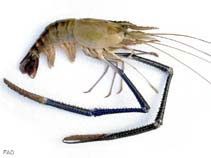Macrobrachium rosenbergii (De Man, 1879)
Giant river prawn| Native range | All suitable habitat | Point map | Year 2050 |

|
| This map was computer-generated and has not yet been reviewed. |
| Macrobrachium rosenbergii AquaMaps Data sources: GBIF OBIS |
Classification / Names Populärnamn | synonymer | CoL | ITIS | WoRMS
Malacostraca | Decapoda | Palaemonidae
Environment: milieu / climate zone / djupintervall / distribution range Ekologi
; sötvatten; brackvatten; djupintervall 0 - 2 m (Ref. 97531). Tropical; 21°N - 18°S, 116°E - 151°E (Ref. 110598)
Distribution Länder | FAO områden | Ekosystem | Förekomster | Utplanteringar
Indo-Pacific: M. rosenbergii actually are two separate species; M. rosenbergii is distributed East of Huxley's Line from the Philippines (including Palawan), Lesser Sunda Islands, New Guinea and northern Australia and M. dacqueti ranges from Pakistan, India, Sri Lanka to the Asian mainland in southern China, Taiwan and up to Malaysia, Borneo and Java.
Length at first maturity / Size / Weight / Age
Könsmognad: Lm ? range ? - ? cm Max length : 34.0 cm TL hane/ej könsbestämd; (Ref. 104052); 26 cm TL (female)
Life cycle and mating behavior Könsmognad | Reproduktion | Lek | Eggs | Fecundity | Larvae
Main reference
referenser | Koordinator | Medarbetare
del Mundo, C.M. 2000 Philippine decapod crustacea. An illustrated handbook on the commercially important decapod crustacea of the Philippines. Fisheries Resources Evaluation and Environmental Services Division, Bureau of Fisheries and Aquatic Resources. Quezon City, Philippines. 83 p. (Ref. 10)
IUCN Red List Status
(Ref. 130435: Version 2025-1)
CITES status (Ref. 108899)
CMS (Ref. 116361)
Threat to humans
Human uses
Fiskeri: kommersiell
FAO - Vattenbruk: production, species profile; fiskeri: landings, species profile | FishSource | Sea Around Us
Verktyg
Ytterligare information
Födosammansättning
Födointag
Predatorer
Max. ages / sizes
Length-weight rel.
Length-length rel.
Length-frequencies
Mass conversion
Abundans
Internet-källor
BHL | BOLD Systems | CISTI | DiscoverLife | FAO(Vattenbruk: species profile; fiskeri: species profile; publication : search) | Fishipedia | GenBank (genome, nucleotide) | GloBI | Gomexsi | Google Books | Google Scholar | Google | PubMed | Tree of Life | Wikipedia (Go, sök) | Zoological Record



